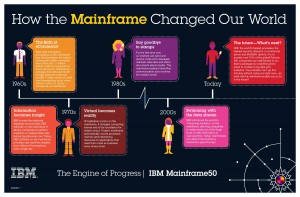Generic
The IBM mainframe: 50 years young
08/04/2014 | Written by: Think Blog redactie (0cB)
Categorized: Generic
Share this post:
By Frank van der Wal
 Last week I had the unique opportunity to visit the IBM Poughkeepsie mainframe production facility, and if there is such a thing as coincidence, it happened to be also the 50th anniversary of that system. Well , not exactly 50 years ago: on the 7th of April to be precise IBM announced the mainframe. At that time a 5 billion dollar, bet-your-company investment. An industrial investment only exceeded by NASA’s Apollo flight program to put a man on the moon.
Last week I had the unique opportunity to visit the IBM Poughkeepsie mainframe production facility, and if there is such a thing as coincidence, it happened to be also the 50th anniversary of that system. Well , not exactly 50 years ago: on the 7th of April to be precise IBM announced the mainframe. At that time a 5 billion dollar, bet-your-company investment. An industrial investment only exceeded by NASA’s Apollo flight program to put a man on the moon.
And if you just think of it. To have a machine still being produced and maintained 50 years after its announcement is a unique happening. None of the systems that were there, still exists. Most of the companies don’t exist anymore for that matter.
The mainframe has been declared dead by many. Wishful thinking. It is stronger than ever, more and more compute power, or MIPS as they call it in the world of mainframes, is sold over the years and there is no indication that it will decline.
What makes the mainframe unique? Surely it was not the first computer. Why it’s leading role over half a century? Let me explain.
Before the mainframe was announced there were computers, or systems as the IT people would prefer to call it. Those systems back then were made for one thing only. IBM’s 1401 and the 704 were designed and built from scratch with a specific purpose in mind, i.e. scientific calculations, for example. Payroll or telling activities, that kind of stuff. Developing a system was the result of a specific need. One system could do … err… one thing.
 In those early 60’s IBM started to realize that it was costly and time consuming to develop systems that could do one thing whereas, from a technical point of view, had things in common. They started to think in a radical different way: a General Purpose machine, that could serve many, if not all, needs.
In those early 60’s IBM started to realize that it was costly and time consuming to develop systems that could do one thing whereas, from a technical point of view, had things in common. They started to think in a radical different way: a General Purpose machine, that could serve many, if not all, needs.
I’ve seen the early Design Principle documents and it is interesting to read that the architects openly ventilated their doubt about the feasibility and the consequences of this approach. They recognised that parts (back then a vast amount of the price) could become cheaper and that production would be more efficient, but were not certain about the success.
To make a general purpose machine, the whole architecture had to be re-invented, processor and other main components had to be re-designed hence the 5 billion dollar investment.
To reflect its ambition of being in the centre of computation in an organisation, the finished product was dubbed System 360. It’s icon was a compass-rose. One of those things I really love.
You may find mainframes boring, or old fashion, but it remains the most reliable platform out there against the lowest possible operating cost imaginable. And that’s a fact! Reliability is build in the design from the very first day. It is designed to perform 24*7 and over the years it only has been approved. Put it symply: A mainframe doesn’t go down. There might be an invite little change that the software might disrupt, but the hardware doesn’t. That’s also a fact.
During the tour through the factory, the proud IBM-er told us that the mainframes today are designed to run 40 years non-stop. And it was a truly magnificent tour. Especially if you´re a technique loving guy as myself. As if I was in the sweetshop. All kind of high-tech and heavy duty stuff out there. The assembly line and the stress test environments were impressive. Every mainframe that goes to customers has has a 100+ hour test cycle of ranging frequencies and temperatures. Even the remote controlled wireless screwdrivers know what torque or which bold has to be mounted. No mistakes allowed here.
I know that the mainframe is not the most popular subject when you are on a party and want to impress your friends with the latest technology. The Smartphones are pulled out and we show off the latest and greatest capabilities of the clever devices. With that mobile stuff we produce every second about 3600 Instagram uploads, about 30.000 tweets and 60.000 Google searches. All impressive numbers, but in the same second 1.15 Million transaction from one of the two mainframe transaction systems, called CICS, are processed. I don’t know the number for the other transaction system, IMS, but let’s assume they are the same. Then we are facing 2.3 Million transactions every tick.
The reason why they run on mainframe is because it is the only system that can guarantee that every transaction is processed. With that amount of transactions you don’t want to hear that 99,9999% is processed correctly, for it will still yield 25 mishits. Every second. No way.
No, the mainframe processes those transactions flawlessly and has the unprecedented capability to have two, three, or many systems geographically dispersed for High Availability and Disaster Recovery scenario’s. All work in sync, all serving the millions and billions of transaction worldwide.
And that capability makes sure that you can rest assure for every –financial– transaction you do. It doesn’t matter if it is EUR 10 or EUR 1.000.000, it will be processed. 50 years ago, today and many years in the future.
Is regulation enabling or hindering innovation in the financial services industry?
Anne Leslie, Cloud Risk & Controls Leader Europe, IBM Cloud for Financial Services Europe’s financial services sector is in the throes of wide scale digital transformation – a transition being accelerated by the growing adoption of digital solutions and services to help keep up with the demands of digitally savvy consumers. While there can be […]
The Digital Operational Resilience Act for Financial Services: Harmonised rules, broader scope of application
The Digital Operational Resilience Act – what and why As part of the European Commission’s Digital Finance Package, the new Digital Operational Resilience Act, or in short DORA, will come into force in the coming period. The aim of DORA is to establish uniform requirements across the EU that improve the cybersecurity and operational resilience […]
Banking on empathy
Suppose you’re owning a small boutique wine shop and have gone through two difficult years because of the Covid-19 pandemic. As the pandemic seems to be on its way back, it is time to revitalize the shop. And this causes direct a huge challenge: the wine stock needs to be replenished but you have used […]



